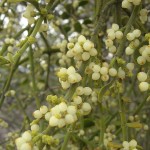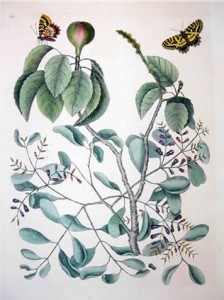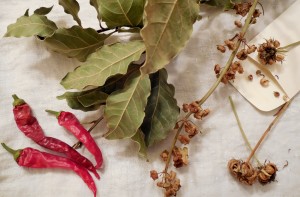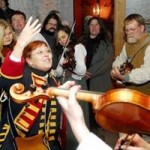30 Décembre, Lundi (Monday)
29 degrees F
Sunny, Light NNW winds
Mistletoe for the new year! Au gui l’an nuef! This old French saying highlights ancient holiday mistletoe traditions in this season of Reveillon and La Guiannée-French Christmas and New Year festivities celebrated in the Illinois Country. These old customs bring with them the foods, music, and conviviality to be shared with family, friends, and the masked participants of La Guiannée. Tortieres, bouillon, croquignoles, pies, cakes, and homemade cordials are served in homes during the season, providing refreshment for the accompanying joyful music and dance, and a stolen kiss under the mistletoe.
Mistletoe is an ancient parasitic evergreen plant named in seasonal lore since ancient times and has its roots both figuratively and literally in its association with the revered oak tree. From the time of the Greeks to the Druids, mistletoe, with its yellow green leaves and white berries, was thought to have mystical properties. People observed that the mistletoe plants, growing on the crowns of oak trees, retained their leaves while at the same time the oaks lost theirs. It seemed to be a remarkable phenomenon and the pervasiveness of mistletoe in customs throughout European holiday customs proves that mistletoe had a deep effect on people’s lives. Viscum album is the traditional mistletoe of literature and Christmas celebrations and it is distributed from Great Britain to northern Asia. Its North American counterpart is Phoradendron serotinum, which clinical trials show may be toxic to humans but birds enjoy the berries and seeds. It has been used as an herbal remedy in Europe and among Native Americans for hundreds of years.
Ancient Greeks believed mistletoe could impart fertility and thus, may bear the origin for the custom of kissing under the mistletoe ball during the holiday season. In France, mistletoe is a New Year tradition. The Illinois country preserves an almost lost French tradition, going from house to house on New Year ’s Eve and singing a song of the mistletoe:
La Guignolee (Guiannée)
Bonsoir le maître et la maitresse.
Et tout le monde du logis.
Pour le premier jour de L’annees.
La Guignolee vous nous deves.
Good evening to the master and mistress,
And to all the people of this household.
For the first day of the year,
You owe us the Guignolee.
First verse of the Saint Genevieve version,
Translation by Judge Wilson Primm
Contained, in this darkest time of the year, are the moments to celebrate the bounty and coming light- filled days of the new year. Bunches of dried herbs have been hung in the rafters or stored in jars and tins along with the seed gathered in late fall. These, with the dried and preserved fruits, berries, and vegetables are the preserved bounty used in holiday preparations to flavor and expand the feast table. The full joy of the garden is displayed in this season of Reveillon and La Guiannée. The seasoning of the meats, pies, cakes, and libations are made richer by what we grow in the garden, making lifelong memories. While readying the rooms and table for the holiday celebrations, gather the holly and the mistletoe, to color our homes and festivities with their ringing promise of “Bonne année et bonne santé!” Good year and good health!
The Prairie du Rocher La Guiannée Society will visit Fort de Chartres on New Year’s Eve around 8 PM. A nice fire will be lit in the fireplace in the Guard’s Room and refreshments will be available beginning around 7 PM and lasting until 9 PM. You are welcomed to the fort to see one of Illinois’ oldest traditions.
Information in this post was gathered from regional sources, including the Ida M. Schaaf Collection, Missouri History Museum Archives, St.Louis, Judge Wilson Primm, “New Year’s Day in the Olden Times of St. Louis”, and Frank H. Tainter, F.H. 2002. What Does Mistletoe Have To Do With Christmas?.




Leave a Reply